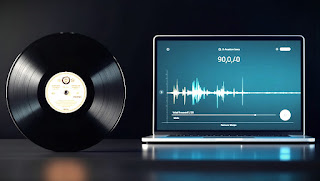How AI Vocal Remover Tools Are Revolutionizing Music Production
For decades, music producers, remix artists, and even casual hobbyists dreamed of a tool that could separate vocals from any song — instantly, cleanly, and without needing access to studio files. Today, thanks to AI vocal remover tools, that dream is no longer sci-fi. It’s real, and it's exploding across the internet.
I first stumbled upon this trend by accident. Scrolling through TikTok, I came across a remix of Taylor Swift’s “Cruel Summer” that stripped away everything but her vocals. The caption read: “Made using an AI vocal remover. Magic?”
I was intrigued. What is this tool? How does it work? And more importantly — was this even legal?
🎶 What Are AI Vocal Removers?
AI vocal remover tools use machine learning algorithms and neural networks trained on thousands of audio tracks to isolate and separate vocals from instrumentals. Unlike old-school methods that relied on phase cancellation or equalizer tricks (which often ruined the sound quality), AI-based solutions like LALAL.AI, Moises, Spleeter by Deezer, and Vocal Remover Pro are much more precise.
These tools can now:
Extract vocals only (ideal for remixing, karaoke, a cappella edits)
Remove vocals completely (great for instrumentals or live performances)
Isolate drums, bass, guitar, or other stems
All this, usually in under a minute.
That’s not just powerful — it’s transformative.
🧑🎤 The Democratization of Music Editing
Back in the day, if you wanted a clean a cappella or instrumental track, you either needed access to studio stems or had to buy licensed multi-track files, which were expensive and often restricted.
Now? A teenager with a laptop and a Wi-Fi connection can remix Beyoncé’s vocals with a lo-fi beat and upload it to YouTube within an hour.
AI vocal removers have leveled the playing field.
Young producers from underrepresented communities — those who couldn't afford software like Pro Tools or Logic Pro — now have access to high-quality editing tools, often for free or a small subscription fee.
In a way, it reminds me of what Instagram filters did to photography — turning casual users into semi-pro artists. This is the Instagram moment for audio editing.
💥 Viral Impact: TikTok, YouTube & the Remix Culture
Platforms like TikTok, SoundCloud, and YouTube Shorts are now flooded with AI-assisted remixes. A user strips the vocals from Eminem’s verse, lays it over a chillhop beat, and suddenly it’s got 2 million views. Another overlays Sufi poetry onto an EDM track — made possible thanks to vocal isolators.
Even major artists are catching on.
In 2024, Billie Eilish’s team officially released isolated stems for fan use, inspired by viral AI remixes. And in early 2025, Ed Sheeran reportedly used an AI-powered vocal remover to pull samples from his old demos and repurpose them in new tracks.
⚖️ But Is It Legal?
Here’s where things get tricky.
While the tech is brilliant, using AI to extract vocals from copyrighted songs and republishing them — even as remixes — often violates copyright law unless you get proper clearance.
Still, platforms are playing catch-up. YouTube, for instance, has started flagging AI-generated content, but enforcement is hit or miss.
Some labels are embracing it, seeing it as free marketing. Others are sending takedown notices.
So, if you're a creator, the safest route is:
Use AI tools for private practice or portfolio projects
Don’t monetize or publicly distribute AI-extracted content without proper rights
🔍 Behind the Scenes: How Does It Work?
Most vocal remover tools use source separation algorithms like:
U-Net convolutional networks
Spectrogram analysis
TensorFlow or PyTorch-based learning frameworks
Trained on massive datasets, they learn to detect vocal frequencies, harmonics, and patterns, then strip them away without damaging the remaining audio. Tools like Spleeter by Deezer can even isolate five different audio stems from one file.
What used to take hours in a studio now takes seconds.
🌍 The Global Trend
According to Exploding Topics, searches for “AI vocal remover” have surged 99x since early 2024. In India, Pakistan, and Nigeria, entire YouTube niches have popped up around remixes of Bollywood songs using AI vocal removers.
In the U.S., Lo-fi remixes of pop hits using stripped vocals are trending across Spotify playlists.
And in Europe, experimental musicians are blending classical instrumentals with AI-extracted voices of jazz legends — creating something completely new.
💭 Final Thoughts: A Tool or a Threat?
Every major leap in music technology comes with pushback.
The synthesizer was once called "soulless".
Auto-tune was mocked for being fake.
Now, AI vocal removers are being called “cheating.”
But tools are just tools. What matters is how we use them.
A vocal remover can be a toy — or it can be a key to creativity. It can produce lazy rip-offs — or unlock stunning musical mashups that could’ve never existed before.
We’re only beginning to see the potential.
As for me? I’ve started using Moises to strip vocals and study harmonies from my favorite songs. And who knows — maybe my next upload will be a viral hit.
💡 Call to Action
If you’ve never tried it, go ahead — take your favorite song, run it through an AI vocal remover, and see what’s hiding beneath the surface. You might just find your next big sound.




Comments
Post a Comment